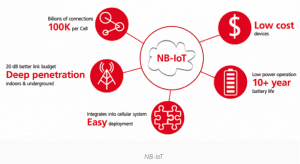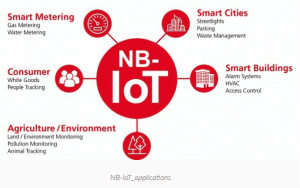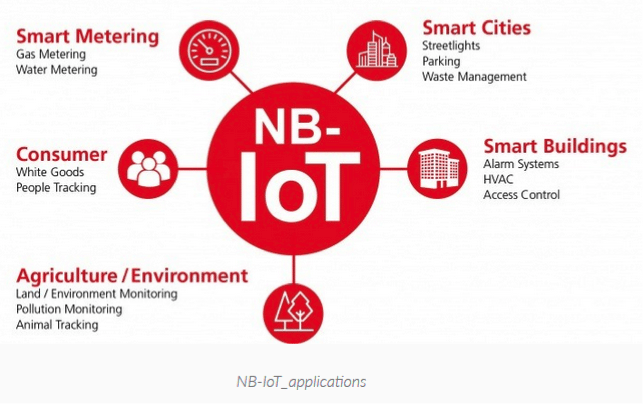The internet of things (IoT) has a last-mile problem. While the cloud infrastructure to gather and analyze data is ready today, a robust wireless infrastructure with the range, low-power and low-cost characteristics to connect large numbers of devices to the internet hasn’t been ready – until recently.
Narrowband IoT, or NB-IoT for short, is a new wireless standard built specifically with low-power, low-cost IoT devices in mind, designed to work with cellular network infrastructure. Rather than having to use proprietary gateways, device makers can concentrate on device functionality instead of worrying about wireless infrastructure.
As a narrowband radio technology, NB-IoT delivers where many other wireless technologies fall short, with its low-power, long-range characteristics and strong signal penetration. These aspects, along with strong mobile industry support, make it ideal for connecting IoT devices to the cloud.
Technology overview

In development for years, NB-IoT was standardized in June 2016 as part of the 3GPP’s Release 13. It’s a narrowband frequency technology that uses only 180kHz bandwidth. This gives it a throughput of only about 27.2kbps down/62.5kb/s (DL/UL) up. While this throughput is relatively low compared to Wi-Fi, Bluetooth or high-end cellular technologies, it’s more than enough for many IoT applications, which simply need to convey state information.
Since the link budget of NB-IoT is concentrated over a narrow frequency band, it’s able to achieve long-range communications with low power usage. In addition, the narrowband nature along with sub-gigahertz deployment means NB-IoT has excellent penetration. Since it uses licensed cellular spectrum, NB-IoT also has better signal integrity and less chance of interference than protocols that have to compete with Bluetooth, Wi-Fi and other protocols on the increasingly cluttered industrial, scientific and medical bands.
While NB-IoT was designed in conjunction with cellular network providers and is hardware-compatible with some existing networks, its protocol is in fact entirely new and separate from existing LTE or 3G protocols. Designed as a “clean slate,” the NB-IoT stack is lean and easy to implement, meaning NB-IoT radio modules are much simpler than most cellular radios, and much more affordable as well.
Instead of relying on gateways like rival IoT wireless protocols, NB-IoT’s cellular nature means that as soon as local network providers support it, designers simply need to add an NB-IoT radio module to a device and it can connect to the Internet. No gateway devices or routers are needed. This simplifies development costs and speeds time to market for many businesses, which would rather focus on their core competencies than build custom wireless infrastructure to support their IoT deployments.
Connecting cities with last-mile infrastructure

While NB-IoT was only standardized in 2016, it’s already been used in the real world to help realize the IoT vision of a modern, connected city. From Germany to Spain to Norway, field trials have proven the success of NB-IoT for these kinds of urban IoT applications.
One of the central promises of the IoT is a better running, more efficient world where resources are monitored and distributed efficiently. The problem is that traditional Wi-Fi, Bluetooth and cellular technologies lack the range, penetration, power or cost characteristics to make this vision a reality.
NB-IoT’s strengths in the urban environment lie in its complementary characteristics to traditional wireless technologies. It offers the range of cellular and the affordability of Bluetooth, along with unbeatable indoor penetration to get around urban obstacles.

Smart metering
In Spain, local water company Aguas de Valencia has used NB-IoT to reduce operating costs and improve visibility. Present in Valencia as well as other parts of Spain, Aguas de Valencia is responsible for over 1 million water meters, each one of which needs to be read at regular intervals. Many utility companies even today do this by sending workers out into the field, but doing this for each and every customer would be cost-prohibitive, and manual readings make it impossible to get information about real-time utility usage.
Automated readings are obviously the solution. Aguas de Valencia had implemented automated meters with great results, but was relying on proprietary technology which required it to not only manage the meters but also the wireless infrastructure to enable the meters to connect to the cloud.
Intrigued by news of NB-IoT, a technology that offloads infrastructure to cellular providers, Aguas de Valencia decided to trial NB-IoT technology from u-blox in its most difficult locations – in basements with little or no cellular coverage, recessed niches with metal covers such as sewers, and other areas where traditional wireless technology has trouble reaching.
The results were astonishing. Every one of the test mobile units installed at typical meter locations had no trouble delivering readings. Agua de Valencia is able to get real-time usage information up to 24 times a day without having to send workers into the field. As NB-IoT is a standardized technology supported by cellular network providers, Agua de Valencia will not need to worry about managing the wireless infrastructure for its water meters. Finally, the battery life enabled by NB-IoT meets or exceeds the 10-year service life of the meters, minimizing the maintenance and operational costs of the system.
Smart parking
As anyone who has circled around the block looking for a parking spot knows, finding parking downtown can be a nightmare. Drivers looking for parking can account for up to 30% of urban traffic congestion. Smart parking therefore aims to relieve the problem of finding a parking spot by using wireless communication to alert drivers to free spaces. Besides helping drivers who need to park, smart parking also indirectly relieves urban congestion by getting drivers off the road.
Smart parking is not a new idea, but it’s had a hard time taking off in the past because of various technical and economic challenges. Using proprietary wireless protocols, most smart parking systems today require operators to not only install parking sensors but the wireless infrastructure that can reach each sensor and connect it to the Internet. This is both cost-prohibitive for many operators as well as technically complex.
NB-IoT resolves these issues, as the individual sensors can communicate directly with the cloud. This not only cuts system costs but greatly simplifies deployment. Installation simply consists of installing parking sensors in the parking lot. Since the devices are battery operated and wireless, no cabling is needed, and since they are cellular, no wireless router is needed.
The potential of NB-IoT for smart parking is great, and it has already been deployed successfully in trials across the world. For example, in January 2017, Q-Free launched a trial project for piloting a new smart parking sensor, in collaboration with one of the world’s largest mobile and communications providers, Telenor, and the Norwegian Public Roads Authority (NPRA). Several smart parking trials have also been performed in China, Spain, Germany and Japan.
Smart agriculture
Besides urban environments, where the indoor penetration of narrowband IoT ensures strong coverage, NB-IoT also excels for smart agriculture. Whereas other wireless technologies would have trouble covering the large areas needed, NB-IoT’s long-range and cellular design make it well suited to precision agriculture applications such as irrigation, pest control or temperature and moisture monitoring.
In Norway, telecom operator Telia partnered with 7sense to create a smart agriculture product using NB-IoT. Using connected sensors detecting water pressure, farmers can monitor their irrigation systems remotely, making sure crops are watered properly and detecting leaks and other issues immediately.
For agriculture, just like with parking and metering, NB-IoT’s value stems not just from its wireless coverage and low-power characteristics, but its incredible ease of deployment. Parking operators, utility companies and farmers have no interest in becoming wireless infrastructure experts; they just want a connected solution that works.
Fast adoption
NB-IoT is currently being rolled out by cellular network providers around the world, from Spain to Norway to South Korea to Japan. The fast adoption of NB-IoT as a wireless IoT standard promises benefits for both network providers and device makers.
Part of the reason for the fast rollout is the easy implementation process. Many network providers can implement NB-IoT with a software upgrade in their infrastructure. Since each base station can accommodate up to approximately 100,000 devices, network capacity is also much less of an issue than with higher bandwidth technologies.
Network providers are incentivized to support NB-IoT as it provides a revenue stream for them into the IoT. While other low-power wide-area (LPWA) technologies have developed independently of cellular, NB-IoT was developed in conjunction with major cellular companies and allows them to provide network coverage on a subscription basis.
For device makers, the rapid adoption of NB-IoT and its standardized nature allows them to design compact and affordable IoT devices that can be deployed, and thus sold, more easily. The support of major network operators and the cellular nature of NB-IoT make it an ideal wireless IoT technology in terms of compatibility and coverage.
Last-mile Wireless for the IoT
While a range of wireless protocols are vying to connect IoT devices to the cloud, only NB-IoT combines the wireless performance, economics and ease of use that is needed for mainstream IoT applications. With strong wireless performance, even in urban environments, long-range, low-power consumption and ease of deployment, NB-IoT may well be the last-mile solution for the IoT.

